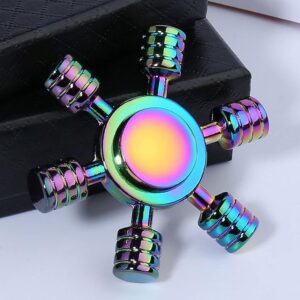The fidget spinner, a simple yet captivating toy, swept the world in a whirlwind of popularity in the mid-2010s. Its seemingly mundane design—a small, handheld device with spinning discs—belied its extraordinary ability to captivate people of all ages. This essay will delve into the rise and fall of the fidget spinner craze, exploring its origins, its appeal, and the factors that contributed to its eventual decline.
The fidget spinner’s origins can be traced back to the 1990s, when a teacher named Catherine Hettinger invented a stress-relief toy for her hyperactive students. Her creation, which she named the “Kat Spinner,” was designed to help children focus and reduce anxiety. However, the toy failed to gain traction in the marketplace at the time.
The resurgence of the fidget spinner in the 2010s can be attributed to several factors. One key factor was the increasing awareness of anxiety and attention deficit hyperactivity disorder (ADHD). As more people sought ways to manage these conditions, the fidget spinner’s potential as a stress-relief tool became apparent. Additionally, the rise of social media platforms like Instagram and TikTok provided a powerful platform for showcasing the toy’s unique appeal. Videos of people performing intricate tricks with fidget spinners quickly went viral, sparking a global trend.
The fidget spinner’s popularity can be attributed to its simple yet addictive design. The act of spinning the device provides a tactile sensation that can be both calming and stimulating. The repetitive motion can also help to induce a state of relaxation, making it an effective tool for stress relief. Moreover, the fidget spinner’s small size and portability make it easy to carry around and enjoy anywhere.
Beyond its practical benefits, the fidget spinner also captured the imagination of people of all ages. Its sleek design and vibrant colors made it a desirable collectible item. Many people found joy in collecting different fidget spinners, each with its own unique features and spinning patterns. The toy’s popularity also gave rise to a thriving online community, where enthusiasts shared tips, tricks, and creations related to fidget spinners.
However, the fidget spinner craze was not without its critics. Some argued that the toy was a distraction in schools and workplaces, while others expressed concerns about its potential to cause injuries. As the toy’s popularity grew, there were also reports of counterfeit fidget spinners made with harmful materials. These factors, combined with the cyclical nature of consumer trends, contributed to the eventual decline of the fidget spinner craze.
Despite its decline, the fidget spinner left a lasting impact on popular culture. It inspired a generation of inventors and entrepreneurs, demonstrating the power of a simple idea to capture the imagination of the world. The toy’s brief reign as a cultural phenomenon also serves as a reminder of the unpredictable nature of consumer trends and the importance of innovation in the marketplace.
In conclusion, the fidget spinner was more than just a toy; it was a cultural phenomenon that captured the hearts and minds of people around the world. Its rise and fall can be attributed to a combination of factors, including its practical benefits, its appeal as a collectible item, and the changing dynamics of consumer trends. While the fidget spinner craze may have faded, its legacy will continue to inspire future inventors and entrepreneurs
Advantages of Fidget Spinners
Fidget spinners, once a popular trend, offered several advantages to those who used them. While their popularity has waned, understanding their benefits can provide insight into potential applications for similar tools.
1. Stress Reduction: One of the primary reasons for fidget spinner popularity was their ability to reduce stress. The repetitive motion of spinning the device can provide a calming sensation, helping individuals to relax and manage anxiety.
2. Improved Focus: For some people, fidgeting can help them to focus and concentrate. The tactile sensation of spinning the fidget spinner can provide a distraction from other thoughts and help individuals to stay on task.
3. Sensory Stimulation: Fidget spinners can provide sensory stimulation, which can be beneficial for individuals with sensory processing disorders or who simply enjoy tactile experiences. The different textures and weights of fidget spinners can offer a variety of sensory inputs.
4. Hand-Eye Coordination: Practicing tricks with fidget spinners can help to improve hand-eye coordination and dexterity. This can be beneficial for individuals of all ages, from children to adults.
5. Autism Spectrum Disorder (ASD) Support: Fidget spinners have been used as a tool to support individuals with ASD. The repetitive motion and sensory stimulation can help to reduce anxiety and improve focus for those on the spectrum.
6. Alternative to Smoking or Nail-Biting: For individuals trying to quit smoking or nail-biting, fidget spinners can provide a healthy alternative to these habits. The repetitive motion can help to satisfy the urge to fidget and reduce the likelihood of relapse.
It’s important to note that while fidget spinners can be beneficial for many people, they may not be suitable for everyone. Some individuals may find them distracting or irritating. It’s essential to try a fidget spinner to determine if it’s a helpful tool for you. Many other such stress reliving toys are available






